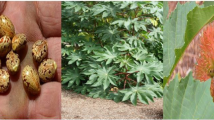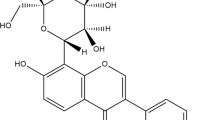Abstract
β-secretase 1 (BACE1) is an enzyme that is involved in generating beta-amyloid peptides and is believed to have a significant role in the development of Alzheimer’s disease (AD). Therefore, BACE1 has gained attention as a potential therapeutic target for treating AD. Modern drug discovery studies are being conducted to identify potential inhibitors of BACE1, with the goal of reducing the production of beta-amyloid peptides and, thus, slowing the progression of AD. Here, we used a multistep virtual screening methodology to identify phytoconstituents from the IMPPAT library that could inhibit the activity of BACE1. Molecular docking was employed to select initial hits based on their binding affinity toward BACE1. Screening for PAINS patterns, ADMET and PASS properties, was then used to identify potential molecules for BACE1 inhibition. In the end, we discovered two natural compounds, Peiminine and 27-Deoxywithaferin A, which demonstrated a strong affinity, effectiveness, and specific interactions for the BACE1-active site. The elucidated molecules also displayed drug likeliness. A 200 ns molecular dynamics (MD) simulation was conducted to investigate the interaction mechanism, complex stability, and conformational dynamics of BACE1 with Peiminine and 27-Deoxywithaferin A. The MD simulations demonstrated that BACE1 was stable during the simulation with Peiminine and 27-Deoxywithaferin A. Overall, the results suggested that Peiminine and 27-Deoxywithaferin A hold significant potential as scaffolds in drug development efforts targeting BACE1 for the purpose of treating AD.









Similar content being viewed by others
Change history
21 March 2024
A Correction to this paper has been published: https://doi.org/10.1007/s11030-023-10804-6
References
Mucke L (2009) Alzheimer’s disease. Nature 461(7266):895–897
Kamat PK (2015) Streptozotocin induced Alzheimer’s disease like changes and the underlying neural degeneration and regeneration mechanism. Neural Regen Res 10(7):1050
Hendrie HC (1998) Epidemiology of dementia and Alzheimer’s disease. Am J Geriatr Psychiatry 6(2):S3–S18
Takahashi RH, Nagao T, Gouras GK (2017) Plaque formation and the intraneuronal accumulation of β-amyloid in Alzheimer’s disease. Pathol Int 67(4):185–193
Vassar R (2004) Bace 1: the β-secretase enzyme in Alzheimer’s disease. J Mol Neurosci 23:105–113
Sathya M, Premkumar P, Karthick C, Moorthi P, Jayachandran K, Anusuyadevi M (2012) BACE1 in Alzheimer’s disease. Clin Chim Acta 414:171–178
Ko MH, Puglielli L (2009) Two endoplasmic reticulum (ER)/ER Golgi intermediate compartment-based lysine acetyltransferases post-translationally regulate BACE1 levels. J Biol Chem 284(4):2482–2492
Zhang X, Song W (2013) The role of APP and BACE1 trafficking in APP processing and amyloid-β generation. Alzheimer Res Ther 5:1–8
Vassar R (2002) β-secretase (BACE) as a drug target for Alzheimer’s disease. Adv Drug Deliv Rev 54(12):1589–1602
Coimbra JR, Marques DF, Baptista SJ, Pereira CM, Moreira PI, Dinis TC et al (2018) Highlights in BACE1 inhibitors for Alzheimer’s disease treatment. Front Chem 6:178
Guo T, Hobbs DW (2006) Development of BACE1 inhibitors for Alzheimer’s disease. Curr Med Chem 13(15):1811–1829
Moussa-Pacha NM, Abdin SM, Omar HA, Alniss H, Al-Tel TH (2020) BACE1 inhibitors: current status and future directions in treating Alzheimer’s disease. Med Res Rev 40(1):339–384
Lahiri DK, Maloney B, Long JM, Greig NH (2014) Lessons from a BACE1 inhibitor trial: off-site but not off base. Alzheimer Dement 10(5):S411–S419
Panza F, Lozupone M, Solfrizzi V, Sardone R, Piccininni C, Dibello V et al (2018) BACE inhibitors in clinical development for the treatment of Alzheimer’s disease. Expert Rev Neurother 18(11):847–857
Chen X, Drew J, Berney W, Lei W (2021) Neuroprotective natural products for Alzheimer’s disease. Cells 10(6):1309
Sharifi-Rad M, Lankatillake C, Dias DA, Docea AO, Mahomoodally MF, Lobine D et al (2020) Impact of natural compounds on neurodegenerative disorders: from preclinical to pharmacotherapeutics. J Clin Med 9(4):1061
Amato A, Terzo S, Mulè F (2019) Natural compounds as beneficial antioxidant agents in neurodegenerative disorders: a focus on Alzheimer’s disease. Antioxidants 8(12):608
Naushad M, Durairajan SSK, Bera AK, Senapati S, Li M (2019) Natural compounds with anti-BACE1 activity as promising therapeutic drugs for treating Alzheimerʼs disease. Planta Med 85(17):1316–1325
Shafie A, Khan S, Mohammad T, Anjum F, Hasan GM, Yadav DK et al (2021) Identification of phytoconstituents as potent inhibitors of casein kinase-1 alpha using virtual screening and molecular dynamics simulations. Pharmaceutics 13(12):2157
Mohammad T, Khan FI, Lobb KA, Islam A, Ahmad F, Hassan MI (2019) Identification and evaluation of bioactive natural products as potential inhibitors of human microtubule affinity-regulating kinase 4 (MARK4). J Biomol Struct Dyn 37(7):1813–1829
Mohanraj K, Karthikeyan BS, Vivek-Ananth R, Chand R, Aparna S, Mangalapandi P et al (2018) IMPPAT: a curated database of Indian medicinal plants, phytochemistry and therapeutics. Sci Rep 8(1):1–17
Mohammad T, Mathur Y, Hassan MI (2021) InstaDock: a single-click graphical user interface for molecular docking-based virtual high-throughput screening. Br Bioinfo 22(4):bbaa279
Biovia DS (2017) Discovery studio visualizer. San Diego, CA, USA, p 936.
DeLano WL (2002) Pymol: an open-source molecular graphics tool. CCP4 Newsl Protein Crystallogr 40(1):82–92
Van Der Spoel D, Lindahl E, Hess B, Groenhof G, Mark AE, Berendsen HJ (2005) GROMACS: fast, flexible, and free. J Comput Chem 26(16):1701–1718
Daina A, Michielin O, Zoete V (2017) SwissADME: a free web tool to evaluate pharmacokinetics, drug-likeness and medicinal chemistry friendliness of small molecules. Sci Rep 7(1):1–13
Turner P (2005) XMGRACE, version 5.1.19. Center for Coastal and Land-Margin Research, Oregon Graduate Institute of Science and Technology, Beaverton, p 2
Hodgson J (2001) ADMET—turning chemicals into drugs. Nat Biotechnol 19(8):722–726
Trott O, Olson AJ (2010) AutoDock Vina: improving the speed and accuracy of docking with a new scoring function, efficient optimization, and multithreading. J Comput Chem 31(2):455–461
Pires DE, Blundell TL, Ascher DB (2015) pkCSM: predicting small-molecule pharmacokinetic and toxicity properties using graph-based signatures. J Med Chem 58(9):4066–4072
Lipinski CA (2004) Lead-and drug-like compounds: the rule-of-five revolution. Drug Discov Today Technol 1(4):337–341
Ferreira LL, Andricopulo AD (2019) ADMET modeling approaches in drug discovery. Drug Discov Today 24(5):1157–1165
Baell JB (2016) Feeling nature’s PAINS: natural products, natural product drugs, and pan assay interference compounds (PAINS). J Nat Prod 79(3):616–628
Lagunin A, Stepanchikova A, Filimonov D, Poroikov V (2000) PASS: prediction of activity spectra for biologically active substances. Bioinformatics 16(8):747–748
Schmid N, Eichenberger AP, Choutko A, Riniker S, Winger M, Mark AE et al (2011) Definition and testing of the GROMOS force-field versions 54A7 and 54B7. Eur Biophys J 40:843–856
Schüttelkopf AW, Van Aalten DM (2004) PRODRG: a tool for high-throughput crystallography of protein–ligand complexes. Acta Crystallogr D Biol Crystallogr 60(8):1355–1363
Wu Y, Tepper HL, Voth GA (2006) Flexible simple point-charge water model with improved liquid-state properties. J Chem Phys 124(2):024503
Khan S, Khan FI, Mohammad T, Khan P, Hasan GM, Lobb KA et al (2018) Exploring molecular insights into the interaction mechanism of cholesterol derivatives with the Mce4A: a combined spectroscopic and molecular dynamic simulation studies. Int J Biol Macromol 111:548–560
Hassan MI, Anjum D, Mohammad T, Alam M, Khan MS, Shahwan M et al (2022) Integrated virtual screening and MD simulation study to discover potential inhibitors of Lyn-kinase: targeting cancer therapy. J Biomol Struct Dyn. https://doi.org/10.1080/07391102.2022.2154849
Mohammad T, Siddiqui S, Shamsi A, Alajmi MF, Hussain A, Islam A et al (2020) Virtual screening approach to identify high-affinity inhibitors of serum and glucocorticoid-regulated kinase 1 among bioactive natural products: combined molecular docking and simulation studies. Molecules 25(4):823
David CC, Jacobs DJ (2014) Principal component analysis: a method for determining the essential dynamics of proteins. In: Livesay DR (ed) Protein dynamics. Springer, Cham, pp 193–226
Papaleo E, Mereghetti P, Fantucci P, Grandori R, De Gioia L (2009) Free-energy landscape, principal component analysis, and structural clustering to identify representative conformations from molecular dynamics simulations: the myoglobin case. J Mol Graph Model 27(8):889–899
Anjum F, Mohammad T, Almalki AA, Akhtar O, Abdullaev B, Hassan MI (2021) Phytoconstituents and medicinal plants for anticancer drug discovery: computational identification of potent inhibitors of PIM1 kinase. OMICS: A J Integr Biol 25(9):580–590
Alotaibi BS, Joshi J, Hasan MR, Khan MS, Alharethi SH, Mohammad T et al (2022) Identifying Isoononin and Candidissiol as Rho-associated protein kinase 1 (ROCK1) inhibitors: a combined virtual screening and MD simulation approach. J Biomol Struct Dyn 2022:1–10
Thaisrivongs DA, Miller SP, Molinaro C, Chen Q, Song ZJ, Tan L et al (2016) Synthesis of verubecestat, a BACE1 inhibitor for the treatment of Alzheimer’s disease. Org Lett 18(22):5780–5783
Naqvi AA, Mohammad T, Hasan GM, Hassan M (2018) Advancements in docking and molecular dynamics simulations towards ligand-receptor interactions and structure-function relationships. Curr Top Med Chem 18(20):1755–1768
Gupta P, Mohammad T, Dahiya R, Roy S, Noman OMA, Alajmi MF et al (2019) Evaluation of binding and inhibition mechanism of dietary phytochemicals with sphingosine kinase 1: towards targeted anticancer therapy. Sci Rep 9(1):1–15
Dahiya R, Mohammad T, Roy S, Anwar S, Gupta P, Haque A et al (2019) Investigation of inhibitory potential of quercetin to the pyruvate dehydrogenase kinase 3: towards implications in anticancer therapy. Int J Biol Macromol 136:1076–1085
Lobanov MY, Bogatyreva N, Galzitskaya O (2008) Radius of gyration as an indicator of protein structure compactness. Mol Biol 42(4):623–628
Durham E, Dorr B, Woetzel N, Staritzbichler R, Meiler J (2009) Solvent accessible surface area approximations for rapid and accurate protein structure prediction. J Mol Model 15(9):1093–1108
Maisuradze GG, Liwo A, Scheraga HA (2009) Principal component analysis for protein folding dynamics. J Mol Biol 385(1):312–329
Acknowledgements
The authors are thankful to the Deanship of Scientific Research, King Khalid University, Abha, Saudi Arabia, for financially supporting this work through the Large Research Group Program under grant number (RGP.2/14/1444). M.A. is thankful to the Deanship of Scientific Research at Shaqra University. The authors are also grateful to Ajman University, UAE for providing all the necessary facilities.
Funding
Funding was provided by King Khalid University (Grant No. RGP.2/137/1443).
Author information
Authors and Affiliations
Contributions
MA: Conceptualization, writing—review and editing, Investigation; Funding acquisition; WAA: Writing—review and editing; Funding acquisition; FAA: Editing, Data curation; MS: Funding acquisition, Data validation, methodology; AS: Visualization, software, Writing—review and editing; Data curation, Methodology, Resources, formal analysis, Project Administration; AA: Conceptualization, Data Curation, Data validation, Resources, Visualization, software, Writing—review and editing; Funding acquisition.
Corresponding authors
Ethics declarations
Conflicts of interest
The authors have no competing conflict of interest to declare.
Additional information
Publisher's Note
Springer Nature remains neutral with regard to jurisdictional claims in published maps and institutional affiliations.
Supplementary Information
Below is the link to the electronic supplementary material.
Rights and permissions
Springer Nature or its licensor (e.g. a society or other partner) holds exclusive rights to this article under a publishing agreement with the author(s) or other rightsholder(s); author self-archiving of the accepted manuscript version of this article is solely governed by the terms of such publishing agreement and applicable law.
About this article
Cite this article
Alrouji, M., Alhumaydhi, F.A., Al Abdulmonem, W. et al. Identifying β-secretase 1 (BACE1) inhibitors from plant-based compounds: an approach targeting Alzheimer’s therapeutics employing molecular docking and dynamics simulation. Mol Divers (2023). https://doi.org/10.1007/s11030-023-10726-3
Received:
Accepted:
Published:
DOI: https://doi.org/10.1007/s11030-023-10726-3




